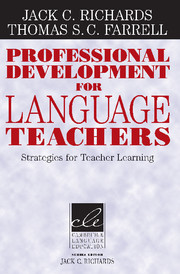Book contents
- Frontmatter
- Contents
- Series editor's preface
- Preface
- 1 The nature of teacher education
- 2 Workshops
- 3 Self-monitoring
- 4 Teacher support groups
- 5 Keeping a teaching journal
- 6 Peer observation
- 7 Teaching portfolios
- 8 Analyzing critical incidents
- 9 Case analysis
- 10 Peer coaching
- 11 Team teaching
- 12 Action research
- Appendix
- Index
5 - Keeping a teaching journal
Published online by Cambridge University Press: 01 February 2010
- Frontmatter
- Contents
- Series editor's preface
- Preface
- 1 The nature of teacher education
- 2 Workshops
- 3 Self-monitoring
- 4 Teacher support groups
- 5 Keeping a teaching journal
- 6 Peer observation
- 7 Teaching portfolios
- 8 Analyzing critical incidents
- 9 Case analysis
- 10 Peer coaching
- 11 Team teaching
- 12 Action research
- Appendix
- Index
Summary
The nature of a teaching journal
A teaching journal is an ongoing written account of observations, reflections, and other thoughts about teaching, usually in the form of a notebook, book, or electronic mode, which serves as a source of discussion, reflection, or evaluation. The journal may be used as a record of incidents, problems, and insights that occurred during lessons; it may be an account of a class that the teacher would like to review or return to later; or it may be a source of information that can be shared with others. The following account by a language teacher describes what she learned from keeping a teaching journal.
Vignette
Recently, I realized from keeping a journal that I tended to focus more on what the class was supposed to be doing, that is, on the lesson plan and the content, and not as much as I should on what the students were actually doing with the material. Moreover, the teaching journal disciplined me to analyze the same students doing basically the same thing day after day until I got this insight from looking at various entries over time in my journal. In other words, I saw this pattern in my classes and I realized that just because I taught the lesson did not mean that the students learned that preplanned lesson. Now I try to answer four questions every day as I write in my journal: What did my students learn today? What helped them learn? What got in the way? What specific evidence can I quote to back up my claims?
Information
- Type
- Chapter
- Information
- Professional Development for Language TeachersStrategies for Teacher Learning, pp. 68 - 84Publisher: Cambridge University PressPrint publication year: 2005
